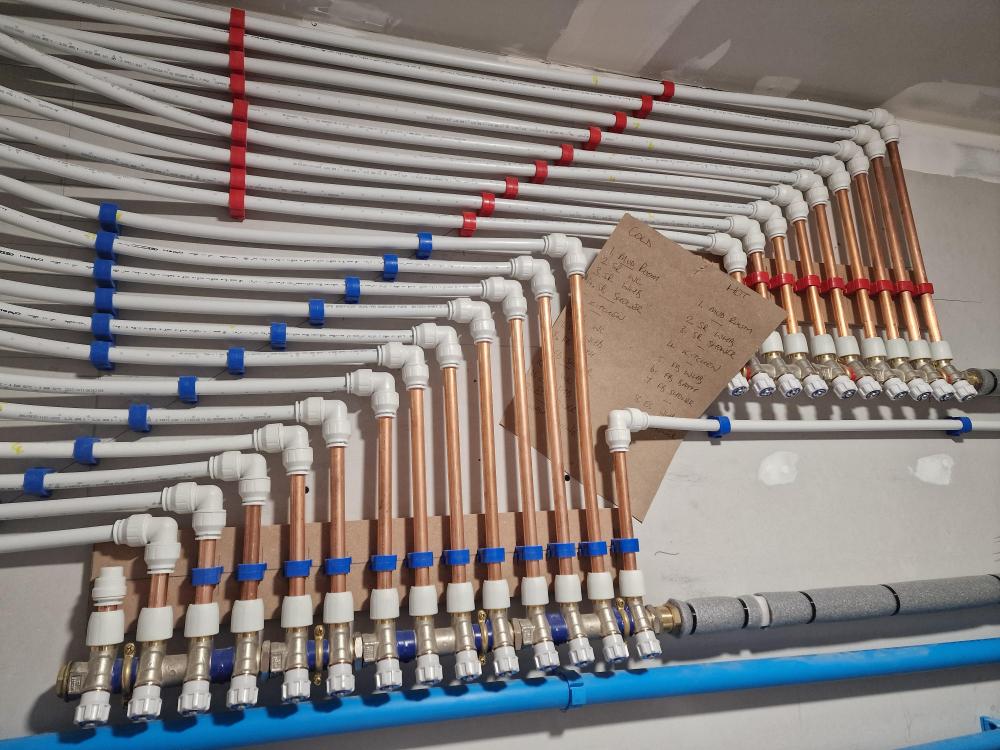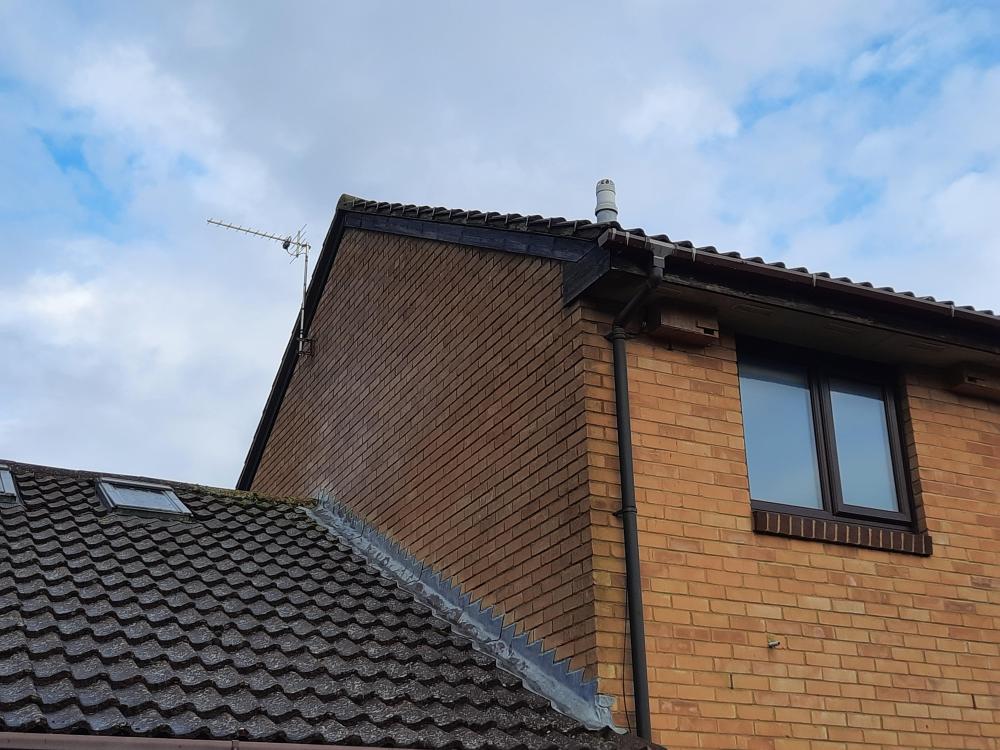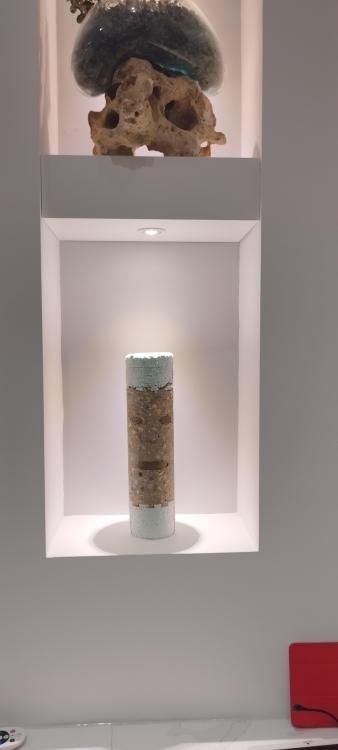Leaderboard
Popular Content
Showing content with the highest reputation on 02/18/24 in all areas
-
Neighbours gutters on the garage were constantly overflowing onto her patio - she’s 85 and needs a walker to get about - not much chance of her getting up a ladder to clear out the gutters so as it stopped raining I thought I’d get it done for her…… Whole length was full of moss/leaves and general detritus Took off the end caps and stuffed a car cleaning sponge down the downpipe and washed them all out into a couple of 35 litre builders buckets Extracted the sponge and the downpipe was blocked up as well so off that came and rodded out a 2 feet of muck but it wasn't all leaves and moss Washed it down and found what was blocking it up I’ve heard the expression “raining cats and dogs” but never heard “raining rats!!!!”1 point
-
1 point
-
1 point
-
Is the door frame sitting on top of the slate, or is the slate butting up against the side of the frame? The choice to not have a cill seems really odd - how is water meant to drain out of the frame? If you're not aware, no matter how well a pvc door is made and installed, water can still end up entering the frame. To handle it, the frame has drainage holes which leads down to the cill. It then either drains over the top of the cill or through it and out the bottom. Something like this: With your setup, I don't see how any water that enters the frame can drain out. That, plus capillary action on the cladding, seems like a likely cause.1 point
-
Yeah that's a lot of BS, we've had the same issues in Scotland with that felt. On slated roofs we don't have battens and it's still an issue. Just a cop out from them making a shitty product.1 point
-
I think I'd want the cladding cut shorter to leave a 10mm gap to let the end grain dry after rain and reduce the risk of capillary action. As above; wall build details would be useful.1 point
-
1 point
-
It aint PTFE pipe and that colleted ebay fitting isn't the right job. as they say above, flick the blue lock collar off and depress the ring just like any other JG fitting... Oh and the fittings unscrew from those filters so you can swap'em onto your choice of BSP ended filters.1 point
-
I'd crack on getting VCL/insulation/PB up personally, you don't currently have "normal" conditions yet?1 point
-
This looks like condensation to me, so you must have dew point conditions around the in-roof GSE plastic formers - the fact that it is wet both sides supports this theory. So warmer damp air hits a cooler surface and condensation forms as the air goes through its dew point. Calculating dew point in the traditional way is a bit of a pain but in 2005 Mark Lawrence came up with a much simple calculation which gives a good approximation, above 50% Relative Humidity (RH) and not far out below. Td = T - ((100 - RH)/5.) you can read all about it here: https://climate.envsci.rutgers.edu/pdf/LawrenceRHdewpointBAMS.pdf. So you can then play with the numbers and get an impression for just when the condensation will happen. I created a simple spreadsheet to help me understand why I was getting vast quantities of condensation on the air tight membrane before the insulation was pumped in. So if the RH is 80% and your air temperature is 9oC and if your plastic unit is at 5oC you will get condensation by this calculation (and the full one). Your situation is all on the outside but it still means that at for every 5% RH drop from 100% the temperature delta increases by 1o C (at 100% the dewpoint is the temperature if you think about it!). You can look at this another way - how is it a problem? You get condensation in roof structures on the outside, the build up design is so arranged that when it happens it is dried out as soon as possible and is kept off the absorbent parts by the membrane.1 point
-
Well, after a night of rain, we checked the attic this morning and the wood to the side of the soil pipe was wet. It looked as if it was coming in from the roof, the far side side of the pipe so probably not the soil pipe/flashing at all. its going to mean removing the tiles off that corner of the roof and seeing if they or the felt is damaged, as well as re-doing the mortar along the whole roof line at the side of the house. It will give me a chance ot paint the wood too as it hasnt been done since we built the garage, 22 years ago. The pipe flashing could get re-newed too, as belt and braces. now i just need to find out how we can get scaffolding up there or if we can do it from ladders (unlikely).1 point
-
1 point
-
By post yeah, but additional invoices will be done online. To be fair all my invoices were scans or digital receipts1 point
-
I don't see any walk on glazing exhibitors - there is a glass splashback company though - great re-purposing of walk on glazing though.1 point
-
Make sure you give the hose a good firm tug, be rough with it. I get the impression from other posters on here that won't be too much of a struggle for ye.1 point
-
1 point
-
A mixing paddle for a drill would speed things up for mixing up a bucket or two.1 point
-
Yes. Pointing doesn't take large quantities so I'd do it by hand, otherwise you may spend more time moving the mixer and cleaning it than actually mixing anything.1 point
-
It's not bad, nice and good quality build, seems good quality overall, works well, now I have my head around flow temperature. Pretty quiet overall, you can program so it doesn't boost the fan at the high speed ever and only does the lowest fan speed overnight. It has an adjustable threshold for water temperature (for cooling and heating) where it switches off the fan. If you set this too low it cools the room instead of heating, if you are not careful. Water temp target temp need to at about 33 to 35, so the water temp doesn't drop below about 28 in any heat pump off cycles, otherwise the fan just drops room temperature. It comes as standard equipped for cooling. Comes with its own programmer, user defined schedule programming etc.1 point
-
A DPC isn't magic. It simply stops moisture being pushed up through a wall by a high water table. A french drain outside would solve this.1 point
-
Help BuildHub financially while getting a £50 credit on your energy account! For anyone considering moving to Octopus Energy, please message me for a referral code. Using that code will result in £100 being split between you and Buildhub. When the credit arrives in my Octopus account, I'll transfer £50 to the BuildHub Paypal account and post a confirmation screenshot in this thread (or to you privately, if you prefer) as proof the transfer happened. As you know, BuildHub is a non-commercial forum run entirely by unpaid volunteers. We pay for hosting etc solely through member donations. If this referral scheme is successful, the need for periodic donation drives will significantly be reduced, or perhaps even done away with completely. Thanks for helping to fund the forum! List of referrals: @trialuser @Dobbie @Jenki @Originaltwist @Chanmenie - Code submitted 30 April 2024 - payment might be a while as not yet connected. @Mattg4321 - Code submitted 3 May 2024.1 point
-
You should be more concerned about your health - the outflow from the flue contains Carbon Monoxide - it can kill and has. You don't smell it, who ever said its fine, shouldn't be allowed near a gas appliance - find a new plumber. Also if its expelling steam you are not condensing so the boiler is not running efficient. Flow temps are set too high. Your return temp needs to be below 53 degs. to ensure condensing.1 point
-
1 point
-
I had no plans for a dryer in our new built, MVHR in the laundry/cloakroom or line in the conservatory (when it’s raining).1 point
-
Ditch the drier, air dry overnight in room vented by MVHR. We've worked with that set up for years. If need be speed up drying time by adding a half hour blast of heat via a fan heater into the closed drying room.1 point
-
We use a clothes horse in the utility room with mvhr, and can dry a washing machine full overnight with no problem, and no condensation or high humidity. We do still have a condensing drier though, in case we need to turn anything round quickly. I'd invest in a new drier rather than mess about trying to duct your old one. Venting directly into the room might put steam into the room at a faster rate than the vent can clear.1 point
-
For the benefit of the search: Vaillant controls calculate energy integral from a starting point of -180° minutes. As each minute passes, the average °C that the flow temperature deviates from the target for that minute is added to the running total, subject to a floor of -180° minutes. i.e. once the target flow is reached, and the HP starts to overshoot, it it were 1°C above the target for 1 minute, the energy integral would then read -179° minutes. Therefore the set range controls the cycle length mid-season, where the ASHP minimum output exceeds thermal load. The default is to turn on compressor at -60° minutes and off at 0° minutes. If that were to be changed to say -90° minutes, then the HP will allow the circuit to cool more leading to a longer cycle period.1 point
-
0 points
-
Ffs ! Saving pennies ! . Buy the proper Hep2o ones . Divorce will cost you more than ” best bargain from China , much goodness , best quality , not rubbish , you pay now ? , my sister waiting also , much goodness , she cheap also , what you want now ? “0 points
-
I may go just to depress myself watching the monied elite.0 points
-
0 points
-
0 points
-
I have declined from answering as I don't have a clue about some made up unit. I strongly suspect "Energy integral" bears little relationship to the true meaning of Integral in mathematics. Differentiation will give you the rate of change of a parameter. Integral gives you the sum over time. All I can remember is "integration by parts" was one of the most difficult areas of maths that I found difficult to understand.0 points
This leaderboard is set to London/GMT+01:00










.jpg.c21f3ac78c9b7efd90cbdcb312744dc5.thumb.jpg.7adcad4c0e384f5ecd7d56b0618df6e5.jpg)






